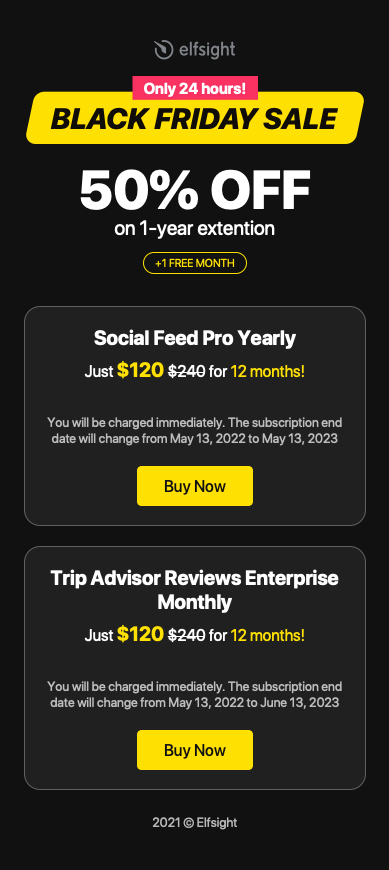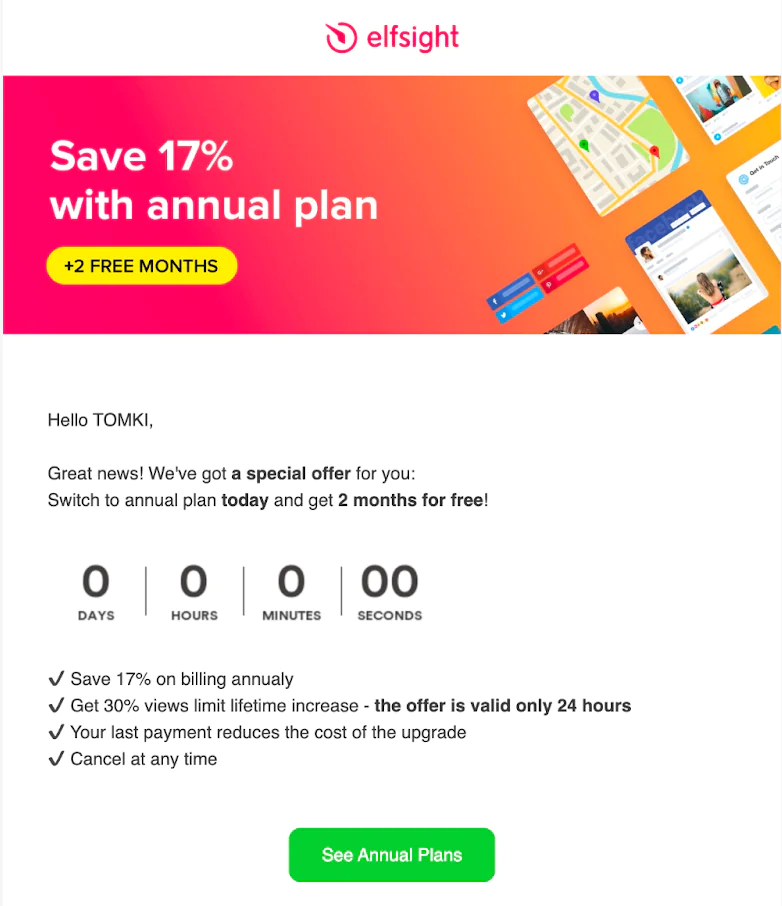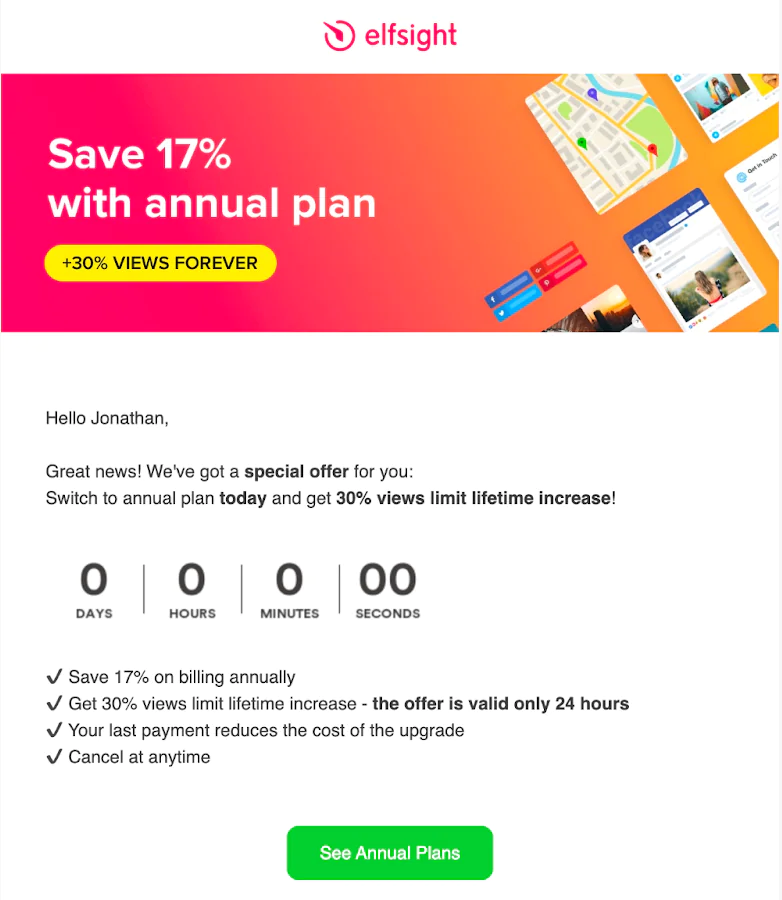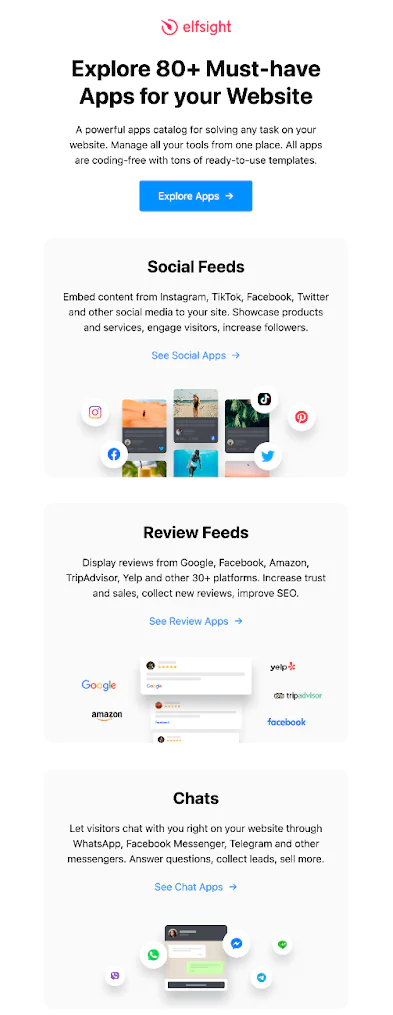Discover how Elfsight leveraged marketing automation to scale its email channel, improve direct communications, and enhance customer retention with Maestra. Learn from their experience!
Elfsight: How Marketing Automation Can Benefit a SaaS Company for Small Businesses
Challenges
Scale up the email channel and develop direct marketing communications
Solutions
Switch to Maestra and launch new types of campaigns for the customer lifecycle
Integrated with:
Website: WordPress frontend; NestJS, Prisma backend; database: MariaDB, Redis
Marketing automation platforms aren’t often implemented in SaaS products. Elfsight has become a rare exception. The company wants to not only scale up its email channel, but develop direct marketing communications as well. To this end, the Elfsight team has implemented a CDP with the aim of automating part of their communications.
In this case study, we will be sharing an honest account of implementation challenges and discrepancies between expectations and reality. This article will be particularly useful for companies planning to work with the email channel.
Main results:
1. We removed developers from the process of preparing and sending campaigns, thereby accelerating the process and reducing the cost of working with the email channel.
2. We obtained more data about bottlenecks in our interactions with customers. When working on campaigns, we studied the user journey in detail and saw how we could optimize it.
3. We got accustomed to constant mass A/B testing in order to evaluate any changes in real data.
4. We received a lot of insights about the efficiency of offers after testing new mailing formats.
Why Elfsight Switched to Maestra and What This Resulted In
Previously, Elfsight used another service to send campaigns. It was inexpensive, but, as the company developed, Elfsight soon outgrew its capabilities:
- Developers had to be involved all the time, which significantly slowed down the launch of campaigns;
- There was a lack of clear analytical reports to speed up the evaluation of results and simplify decision-making;
- There was no convenient interface to test campaigns.
In order to scale up the email channel and develop direct communications, Elfsight needed to either create an in-house solution that would meet the necessary requirements or look for a ready-made solution. The first option required a lot of work, and it was much faster and cheaper to integrate a ready-made service.
We considered several solutions, ranging from simple mailing services to full-fledged marketing automation platforms.
We picked Maestra because:
— We saw a great scope of features that could be useful as our company continued to grow. For example, the ability to use Maestra as a unified direct communication platform, which can help us communicate with our customers in different channels, launch pop-ups, push notifications and connect chatbots in messengers.
— Maestra beat the competition in terms of cost when calculating the sum of the functionality we needed and the size of the customer database.
— Some of our teammates had a successful experience implementing direct marketing using Maestra on other projects.
Elfsight’s integration with Maestra was not quite like others. The Elfsight team did not want to introduce third-party scripts into the company’s service, so all data was transferred to Maestra’s CDP from the backend.
The platform is clear and intuitive. If one has worked with similar software, they’ll have no problem figuring it out quickly.
However, the interface sometimes seems to be a bit tricky. There are a few cases where basic tasks cannot be performed at all.
For example:
— When deleting a customer, their statistics get erased from the campaign data, making the historical data absolutely useless;
— Cumbersome filter structure. Parameters duplicate themselves in different categories, and sometimes even Maestra employees get confused working it all out.
— Minor interface flaws: no option to sort campaigns alphabetically or by creation date, for instance.
I guess it’s worth mentioning that the cost of the service scales up unevenly with the user base growth, which greatly increases email channel expenses. Since it’s rather expensive to keep more than 300,000-500,000 customers in Maestra, we use another database to store the majority of the users. This means we have to maintain two solutions simultaneously, which makes the process complex for both developers and marketers.
Maestra’s manager, Kirill Sidorenko, helped us greatly with the project. He accelerated the integration process significantly. Kirill is tech-savvy, result-oriented and highly engaged.
A special thanks to Tatiana Evmenchikova and Ksenia Seregina from the support service, who helped with the practical issues of working with Maestra.
Elfsight Identified Bottlenecks in the Product
With the email channel scaling up, Elfsight got the opportunity to work on increasing retention metrics. At the same time, the team was able to determine exactly what prevented this metric from growing and what complicated the user experience. For example:
- Authorization when logging in from another device. Many users read emails from their phones but sign up for Elfsight Apps from their computers. As a result, if emails contained links to the dashboard, users ended up on the authorization page trying to open them from mobile devices. This really complicated the user journey.
To exclude all the redundancies from the user journey, we embedded links for authentication through any device. - No one-click payment. Some emails offer users to change their plan or billing period. The payment process was not transparent, which led to a negative effect on the conversion rate.
To simplify this process, we developed separate landing pages with individual promotional offers, where a user could pay for the upgrade or a new product in just one click. We tested these kinds of pages on Black Friday, New Year’s Eve, and other promotions, and they proved highly successful.

- Inconsistency of offers in the Elfsight service and campaigns. Sometimes, a user would receive an email with an offer and visit the Elfsight dashboard, only to find that the information for that offer is either not there or completely different from the email. This confused the user and prevented them from making a decision.
Currently, all offers are synchronized in a single database of user deals in Elfsight. They are then transmitted to campaigns, the dashboard and all other channels.
Elfsight Can Better Understand Users With Regular A/B Testing
Previously, the Elfsight team were unable to implement quick A/B tests in campaigns, since the solution they were using had limited functionality. Now, in Maestra’s interface, Elfsight sets up tests in a matter of minutes, and carries out plenty of tests on a regular basis.
For example, Elfsight decided to look into offers that motivate customers to switch from a monthly subscription to an annual one. The team compared how the conversion rate would change if they offered not only savings due to the upgrade, but also an additional benefit: 2 bonus months for free, or a 30% increase on view limits.
It’s worth mentioning that, for many companies, each offer has its own cost, which means that each offer has a different impact on product margins and the maximum CAC. A/B tests are a great tool to strike a balance between conversion rates and the company’s costs.

Without bonus offer
-
Click rate1.2%
-
Conversion rate4%

Offer “2 months of Elfsight for free”
-
Click rate2.9%
-
Conversion rate9%

Offer “30% extra views”
-
Click rate2.4%
-
Conversion rate9%
Elfsight’s case reveals that extra bonuses such as two free months and a 30% increase in view limits motivated users equally, while significantly increasing the conversion rate in comparison with the initial offer. These bonuses now help the team to convert users much more efficiently.
Arranging Communications Around the Customer Lifecycle
The most important part of Elfsight communications is the welcome series, which has a strong impact on the conversion of registered users to paying customers. Emails in this sequence come at every stage of interaction with the service and help users move on to the next one:
- A welcome email with a welcome coupon sent immediately after registration, and a reminder sent sometime later;
- Several reminders prompting users to create their first widget;
- Several reminders about widget installation, offering assistance;
- A reminder about an expiring welcome discount;
- Last-chance email for inactive users, sent a week after registration.
The welcome email series also lets the team segment users and keep them engaged.

Welcome email with a coupon

Widget Creation Reminder

Widget Installation Reminder
Lessons Learned about Direct Marketing Automation
- First specify a responsible person, then focus on scaling up the channel. When launching direct marketing, it’s definitely worth hiring or allocating a person responsible for key metrics (an email marketer or CRM manager), since the tasks are very specific and require deep immersion in the process. A large user database won’t allow for rushing through or completing tasks instantly.
- Take care of analytics from the very beginning. It’s not worth postponing work on analytics. It’s crucial to immediately identify the channel’s key tasks and metrics, select attribution models and develop reports in order to make the result of the work transparent to everyone.
- Always set aside resources for additional tasks. The integration process inevitably includes unexpected technical problems or unforeseen scenarios. Therefore, when planning your integration, it’s better to be realistic and set aside time to deal with problems as they arise. Otherwise, the platform’s payback period will end up getting delayed, which will push back any results from the integration to a much later date.


